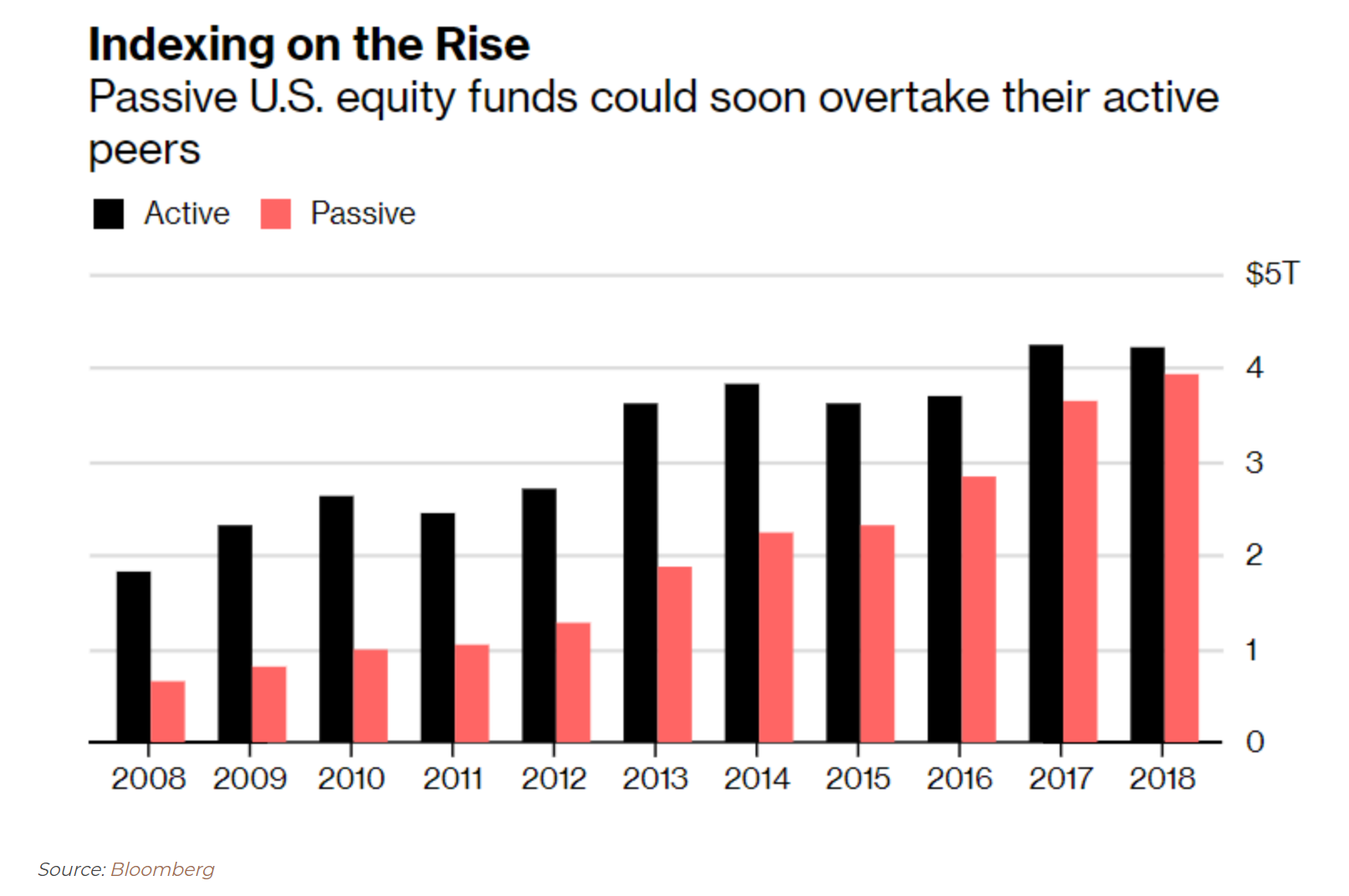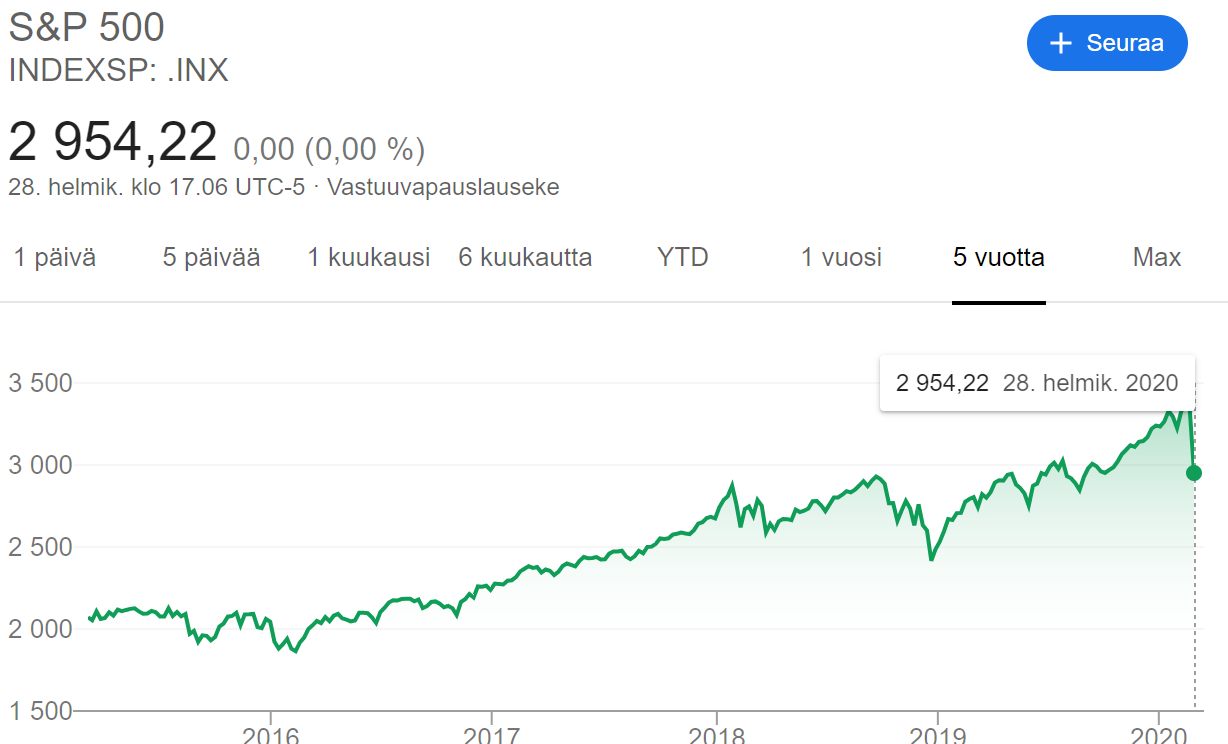Index investing and ETF’s
Written By: Milja Mieskolainen
Index investing is a passive investing strategy. The index itself describes the price development of a specific set of commodities or securities. The most well-known index is the stock index, which describes the development of a specific market. Examples include OMXH25 from Helsinki, Standard & Poor's 500 from the US, Nikkei 225 from Japan, DAX from Germany and FTSE100 from the UK.
The development of S&P 500 -index during the past five years
The best-known way to build an index, for example, is to weight shares based on their market value. In this case, a share with a larger market cap has a higher weight in the index. This can become problematic if bubbles start forming in the market or if the market is highly concentrated. This was the case in the Helsinki Stock Exchange during the IT bubble, when Nokia's share in the index was already over 50%.
In principle, an index can be formed in any way. At its simplest, 100 companies are taken and each weighted at 1%. Listed below are other, "smarter" ways to form an index.
Here is a list of other, more educated ways of forming an index:
- Small-cap index / mid-cap index / large cap index
- Value stock index (companies are chose based on low P/E and P/B ratios)
- Growth stock index (high P/B ratio, expected growth in revenue and income)
- Quality stock index (profitability is high year-to-year and leverage is low)
- Dividend stock index (high dividend yield and/or rapid dividend yield growth)
- Momentum stock index (stocks that have generated higher short-term returns)
- Minimum volatility and risk adjusted index (emphasis on low-risk stocks)
Source: Sijoittaja.fi
The index itself is only a figure and you cannot invest in it per say. However, this problem is solved with index funds and ETFs. Index funds can be purchased directly from various asset management companies and ETF’s are traded on the stock exchange. Other differences between the two include management fee differences (generally slightly lower in ETF’s), subscription and redemption fees (not charged in ETF’s but stockbroker fees paid upon purchase) and dividend reinvestment (ETF’s rarely do so).
In addition to the index, ETF’s may invest in commodities such as gold or oil. They can also be used to invest in foreign stock exchange products, such as the S&P 500 index mentioned above or, for example, the Asian market. Therefore, you should also carefully familiarize yourself with ETF’s before purchase, as they may contain complex products that are difficult to value. It is also worth noting that ETF’s are generally inactive, but some are actively managed, which can increase costs. Overall, ETF’s tend to offer good diversification benefits and usually achieve average market returns. They are not necessarily 'boring' either, as you can also find special ETF’s on the stock market, such as those investing in emerging markets.
There are several classes of ETFs, each with its own pros and cons.
- Most ETF’s are stock ETF’s. They invest their assets either in an index or in some "smart" way, such as in high dividend stocks. ETF’s that invest in the index get market-based returns, and investors who invest in other ways can achieve abnormal returns, both positive and negative.
- Interest rate ETF’s can be divided into those investing in government bonds and those investing in corporate bonds. These include both high- and low-risk bonds. These allow the investor to, for example, invest in emerging market government bonds or reduce the risk of their portfolio by choosing the right products.
- REIT (Real Estate Investment Trust) ETF’s invest their assets in listed REIT’s, which are required to distribute 90% of their assets in dividends. By investing in such an ETF, assets will be diversified into several REIT’s and thus, into thousands of different properties.
- A fund that complies with certain regulations, invests extensively in commodities and is listed on a stock exchange is an ETF. If the fund invests in only one commodity, it is an ETC (exchange traded commodity). Commodity investments can provide diversification benefits when coupled with stocks.
It is also worth paying attention to the value of assets managed by ETF’s, as smaller tranches may be exposed to liquidity risk, meaning you may not be able to sell them immediately. They can be quite complex in structure and function; physical and synthetic, levered and inverted. You must be prepared to get to know them but investing through ETFs is fairly inexpensive and you have access to a large supply.
- Physical ETF funds directly own each security according to the index. For example, if the ETF focuses on the 25 largest companies on the Helsinki Stock Exchange (OMXH25), it holds shares in these companies in the same proportion as they are in the index.
- Synthetic ETF’s are made up entirely of derivative contracts. The asset manager may buy a basket of securities and sign a SWAP contract with the counterparty, who in gives the benchmark index return in exchange for the share basket returns. Thus, the owner of an ETF does not directly own the index-linked securities but is entitled to a return thereon.
- Leveraged ETF’s are a relatively new phenomenon. They use at least double leverage to boost the index's return. Its value is recalculated daily based on the closing price of the previous day.
- The reverse ETF reacts oppositely to the index being followed. As the index falls, the value of the reverse ETF rises. Such ETF’s are generally not suitable for long-term investment, but can be used, for example, to prepare for stock price fluctuations.
An index fund differs from an ETF in that it cannot be converted into cash at any time during the opening hours of the stock exchange. They can only be bought and sold once a day at the closing price. The range of index funds is also narrower, as they are usually broken down by geographical area. However, it is possible to find completely cost-free index funds that are easy and hassle-free to invest in. Their operating logic is also easy to understand, they’re relatively effortless and they’re easy to start investing in.
Both these passive investment strategies offer a more affordable way to invest, in comparison to actively managed funds. They can also provide an average market return depending on the index being followed. The market average is not bad, as most actively managed funds will lose to the index in the long run. Index funds can be a good choice as a long-term investment, while ETFs are easier to trade in the short-term. Both methods require familiarization, but with effort you can achieve good decentralization benefits.
More information on the topic:
Financial Times article: Popularity of passive investing changes the rules of the game
Book: The Clash of Cultures, John C. Bugle
Video: What is an index? - MoneyWeek (15min)


